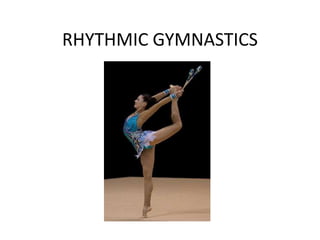Rhythmic gymnastic
•Descargar como PPTX, PDF•
1 recomendación•2,808 vistas
Rhythmic gymnastics originated in 1930 in the Soviet Union and became an Olympic sport in 1984 when Lori Fung won the gold medal. The document describes the apparatus used in rhythmic gymnastics - the ball, rope, ribbon, clubs, and hoop - and notes the basic dimensions, weights, and rules for each regarding touching the floor and resulting penalties. It does not provide any information about the Spanish rhythmic gymnastics team.
Denunciar
Compartir
Denunciar
Compartir

Recomendados
Más contenido relacionado
La actualidad más candente
La actualidad más candente (20)
Presentation on modern & historic perspective of physical education in usa

Presentation on modern & historic perspective of physical education in usa
Destacado
Destacado (6)
Más de Maribel1960
Más de Maribel1960 (6)
Rhythmic gymnastic
- 2. HISTORY • Rhythmic gymnastics was created in 1930, in the Soviet Union. • In 1984 it became an Olympic discipline. Lori Fung was the winner of those games.
- 3. BALL • The diameter of the ball is of 18-20 cm. • Its weight is about 400 grammes. • It can be of different colours.
- 4. ROPE • The length of the rope depends on the gymnast: it has to have the distance from the shoes to the shoulders. • If the rope touches the floor the gymnast is penalized.
- 5. RIBBON • The length of the ribbon is about 4-6 metres. • The ribbon can not touch the floor, because it will be penalized.
- 6. CLUBS • The weight of each club is 150 grammes. • The clubs are made of plastic. • The club can´t touch the floor, because it will be penalized.
- 7. HOOP • The diameter of the hoop is of 80-90 cm. • Its weight about 300 grammes. • The hoop can´t touch the floor, because it is penalized.